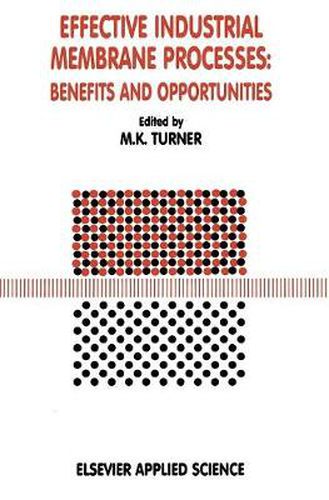Readings Newsletter
Become a Readings Member to make your shopping experience even easier.
Sign in or sign up for free!
You’re not far away from qualifying for FREE standard shipping within Australia
You’ve qualified for FREE standard shipping within Australia
The cart is loading…






This title is printed to order. This book may have been self-published. If so, we cannot guarantee the quality of the content. In the main most books will have gone through the editing process however some may not. We therefore suggest that you be aware of this before ordering this book. If in doubt check either the author or publisher’s details as we are unable to accept any returns unless they are faulty. Please contact us if you have any questions.
The aim of the Technical Advisory Committee, in planning the c~:>Dtent of this meeting, was to illustrate the range of separation processes in which the use of membranes was practical and effective at an industrial scale. As Professor Strathmann reveals, the market for process equipment built around membranes is now worth about $5x1(f annually, and it seemed important to review this technology, and to point the direction of future technical advances. All but the most critical reader should find some items of interest. The Committee would admit to not fulftlling all of thier aims, although those delegates who attended the meeting in Edinburgh judged it a success. In the event it provided representative examples of processes from the food and beverage industry, from water treatment, and from the chemical industry, of which the removal of alcohol from fermented beverages, shipboard desalination and solvent recovery are three. The major uses of charged membranes and sterile processes are not covered, nor 9 is the largest market, $1.2x10 annually, for artificial kidney dialysis. However, it is interesting to see artificial kidney now finding an alternative use as a reactor for the production of monoclonal antibodies. We are also reminded by Professor Michel of the importance and efficiency of natural membranes in the kidney under conditions where fouling is crucial to their performance and enhances their selectivity.
$9.00 standard shipping within Australia
FREE standard shipping within Australia for orders over $100.00
Express & International shipping calculated at checkout
This title is printed to order. This book may have been self-published. If so, we cannot guarantee the quality of the content. In the main most books will have gone through the editing process however some may not. We therefore suggest that you be aware of this before ordering this book. If in doubt check either the author or publisher’s details as we are unable to accept any returns unless they are faulty. Please contact us if you have any questions.
The aim of the Technical Advisory Committee, in planning the c~:>Dtent of this meeting, was to illustrate the range of separation processes in which the use of membranes was practical and effective at an industrial scale. As Professor Strathmann reveals, the market for process equipment built around membranes is now worth about $5x1(f annually, and it seemed important to review this technology, and to point the direction of future technical advances. All but the most critical reader should find some items of interest. The Committee would admit to not fulftlling all of thier aims, although those delegates who attended the meeting in Edinburgh judged it a success. In the event it provided representative examples of processes from the food and beverage industry, from water treatment, and from the chemical industry, of which the removal of alcohol from fermented beverages, shipboard desalination and solvent recovery are three. The major uses of charged membranes and sterile processes are not covered, nor 9 is the largest market, $1.2x10 annually, for artificial kidney dialysis. However, it is interesting to see artificial kidney now finding an alternative use as a reactor for the production of monoclonal antibodies. We are also reminded by Professor Michel of the importance and efficiency of natural membranes in the kidney under conditions where fouling is crucial to their performance and enhances their selectivity.